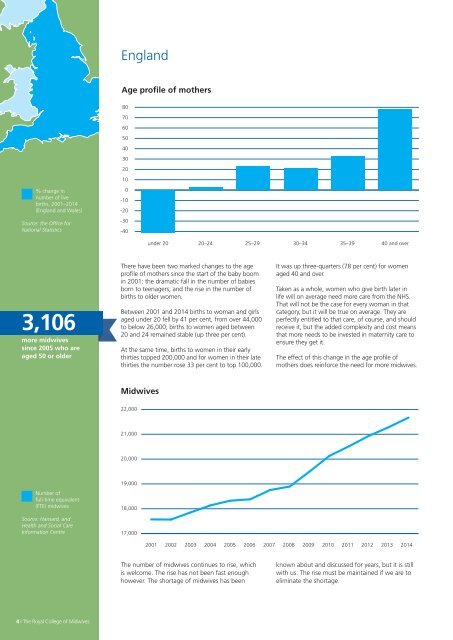Create successful ePaper yourself
Turn your PDF publications into a flip-book with our unique Google optimized e-Paper software.
England<br />
Age pr<strong>of</strong>ile <strong>of</strong> mothers<br />
% change in<br />
number <strong>of</strong> live<br />
births, 2001–2014<br />
(England and Wales)<br />
Source: the Office for<br />
National Statistics<br />
80 80<br />
70 70<br />
60 60<br />
50 50<br />
40 40<br />
30 30<br />
20 20<br />
10 10<br />
0<br />
-10 -10<br />
-20 -20<br />
-30 -30<br />
-40 -40<br />
under 20<br />
20–24 25–29 30–34 35–39 40 and over<br />
3,106<br />
more midwives<br />
since 2005 who are<br />
aged 50 or older<br />
There have been two marked changes to the age<br />
pr<strong>of</strong>ile <strong>of</strong> mothers since the start <strong>of</strong> the baby boom<br />
in 2001: the dramatic fall in the number <strong>of</strong> babies<br />
born to teenagers; and the rise in the number <strong>of</strong><br />
births to older women.<br />
Between 2001 and 2014 births to woman and girls<br />
aged under 20 fell by 41 per cent, from over 44,000<br />
to below 26,000; births to women aged between<br />
20 and 24 remained stable (up three per cent).<br />
At the same time, births to women in their early<br />
thirties topped 200,000 and for women in their late<br />
thirties the number rose 33 per cent to top 100,000.<br />
It was up three-quarters (78 per cent) for women<br />
aged 40 and over.<br />
Taken as a whole, women who give birth later in<br />
life will on average need more care from the NHS.<br />
That will not be the case for every woman in that<br />
category, but it will be true on average. They are<br />
perfectly entitled to that care, <strong>of</strong> course, and should<br />
receive it, but the added complexity and cost means<br />
that more needs to be invested in maternity care to<br />
ensure they get it.<br />
The effect <strong>of</strong> this change in the age pr<strong>of</strong>ile <strong>of</strong><br />
mothers does reinforce the need for more midwives.<br />
Midwives<br />
22000 22,000<br />
21000<br />
21,000<br />
20000<br />
20,000<br />
Number <strong>of</strong><br />
full-time equivalent<br />
(FTE) midwives<br />
Source: Hansard, and<br />
Health and Social Care<br />
Information Centre<br />
19000<br />
19,000<br />
18000<br />
18,000<br />
17000 17,000<br />
2001 2002 2003 2004 2005 2006 2007 2008 2009 2010 2011 2012 2013 2014<br />
The number <strong>of</strong> midwives continues to rise, which<br />
is welcome. The rise has not been fast enough<br />
however. The shortage <strong>of</strong> midwives has been<br />
known about and discussed for years, but it is still<br />
with us. The rise must be maintained if we are to<br />
eliminate the shortage.<br />
4 | The Royal College <strong>of</strong> Midwives


